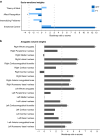Amygdala volumes and associations with socio-emotional competencies in preterm youth: cross-sectional and longitudinal data
- PMID: 38762662
- PMCID: PMC11772232
- DOI: 10.1038/s41390-024-03227-y
Amygdala volumes and associations with socio-emotional competencies in preterm youth: cross-sectional and longitudinal data
Abstract
Background: Socio-emotional difficulties often result from very preterm (VPT) birth. The amygdala's developmental trajectory, including its nuclei, has been recognized as a significant factor in observed difficulties. This study aims to assess the relationship between amygdala volume and socio-emotional competencies in VPT children and adolescents.
Methods: Socio-emotional competencies were assessed, and amygdala volumes, including subnuclei, were extracted automatically from structural scans in a cross-sectional cohort of VPT (n = 75) and full-term (FT, n = 41) aged 6-14 years. Group differences in amygdala volumes were assessed using ANCOVA, and associations with socio-emotional competencies were studied using partial least squares correlation (PLSC). In a VPT subgroup, additional longitudinal data with amygdala volumes at term-equivalent age (TEA) were manually extracted, growth rates calculated, and associations with school-age socio-emotional competencies investigated using PLSC.
Results: Using cross-sectional data at school-age, amygdala volumes displayed comparable developmental patterns between the VPT and the FT groups. Greater volumes were associated with more emotional regulation difficulties in VPT and lower affect recognition competencies in FT. In the longitudinal VPT subgroup, no significant associations were found between amygdala volume trajectory and socio-emotional competencies.
Conclusion: Although our findings suggest typical amygdala development after VPT birth, further research is necessary to elucidate the developmental trajectory of amygdala and the role of resilience factors.
Impact: In our cohort, amygdala volumes, including subnuclei, displayed comparable developmental trajectories between the very preterm and the full-term groups. Higher amygdala volumes at school-age were associated with higher emotional regulation difficulties in the very-preterm born group, and with lower affect recognition abilities in full-term born children and adolescents. In a subgroup of very-preterm children and adolescents followed from birth to school-age, no significant associations were found between amygdala volumes at term-equivalent age and socio-emotional competencies at school-age.
© 2024. The Author(s).
Conflict of interest statement
Competing interests: The authors declare no competing interests. Ethics approval and consent to participate: This study was approved by the Swiss Ethics Committees on research involving humans, ID: 2015-00175. Written informed consent was obtained from the principal caregiver and from the participant.
Figures




Similar articles
-
Exploring the Long-Lasting Effect of Mindfulness-Based Intervention in Very Preterm Adolescents on Executive and Socio-Emotional Competencies.Child Care Health Dev. 2025 Mar;51(2):e70051. doi: 10.1111/cch.70051. Child Care Health Dev. 2025. PMID: 40097314
-
Large-scale brain network dynamics in very preterm children and relationship with socio-emotional outcomes: an exploratory study.Pediatr Res. 2023 Jun;93(7):2072-2080. doi: 10.1038/s41390-022-02342-y. Epub 2022 Nov 3. Pediatr Res. 2023. PMID: 36329223 Free PMC article.
-
The effect of a mindfulness-based intervention on executive, behavioural and socio-emotional competencies in very preterm young adolescents.Sci Rep. 2021 Oct 6;11(1):19876. doi: 10.1038/s41598-021-98608-2. Sci Rep. 2021. PMID: 34615893 Free PMC article. Clinical Trial.
-
Socio-Emotional Development Following Very Preterm Birth: Pathways to Psychopathology.Front Psychol. 2016 Feb 12;7:80. doi: 10.3389/fpsyg.2016.00080. eCollection 2016. Front Psychol. 2016. PMID: 26903895 Free PMC article. Review.
-
Alterations in development of hippocampal and cortical memory mechanisms following very preterm birth.Dev Med Child Neurol. 2016 Mar;58 Suppl 4(Suppl Suppl 4):35-45. doi: 10.1111/dmcn.13042. Dev Med Child Neurol. 2016. PMID: 27027606 Free PMC article. Review.
Cited by
-
Early childhood stress and amygdala structure in children and adolescents with neurodevelopmental disorders.Brain Struct Funct. 2025 Jan 11;230(1):29. doi: 10.1007/s00429-025-02890-z. Brain Struct Funct. 2025. PMID: 39797953
References
-
- Arpi, E. & Ferrari, F. Preterm birth and behaviour problems in infants and preschool-age children: a review of the recent literature. Dev. Med Child Neurol.55, 788–796 (2013). - PubMed
-
- Cheong, J. L. et al. Association Between Moderate and Late Preterm Birth and Neurodevelopment and Social-Emotional Development at Age 2 Years. JAMA Pediatr.171, e164805 (2017). - PubMed
MeSH terms
LinkOut - more resources
Full Text Sources

